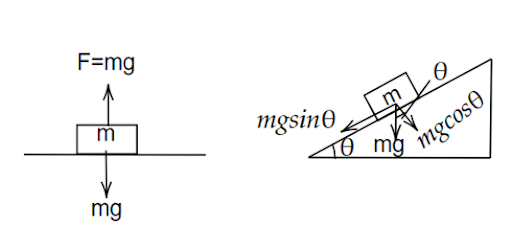
It is easier to draw up a wooden block along an inclined plane than to haul it vertically, this is because.
A. The friction is reduced
B. the mass becomes smaller
C. only a part of the weight has to be overcome
D. g becomes smaller
Answer
217.5k+ views
Hint:Before we start addressing the question, we need to know about the inclined plane. It is a simple machine that consists of a sloping surface that is used for raising heavy bodies. If the incline plane’s angle keeps getting steeper, the force required also increases till it becomes equal to the weight of the object.
Formula Used:
To find the force on an inclined plane,
\[F = mg\]
Where, m is mass and g is acceleration due to gravity.
Complete step by step solution:

Image: A wooden block on a horizontal plane and on an inclined plane.
Consider an inclined plane in which a block of mass m is placed, so that, due to the weight of the block the force acts downwards as \[F = mg\] and this splits into two components \[mg\sin \theta \] along the x-axis and \[mg\cos \theta \] along the negative y-axis(downwards) and normal force acting along the upwards.
Now, if we apply an opposite force on the block, it is equal to \[mg\sin \theta \] and less than mg, because the downward force \[mg\cos \theta \] is balanced by the normal force. So, only one part of the weight will be overcome by \[mg\sin \theta \].
The force required is more to lift the block vertically compared to the force which is required to move a block on the inclined plane. Therefore, it is easier to draw up a wooden block along an inclined plane than to lift it vertically, then only one part of the work will be overcome.
Hence, option C is the correct answer.
Note:Remember that only a component of weight acts along the inclined plane, that is, only a part of weight has to be taken care of by the applied force. That is why an inclined plane is used to lift weights.
Formula Used:
To find the force on an inclined plane,
\[F = mg\]
Where, m is mass and g is acceleration due to gravity.
Complete step by step solution:

Image: A wooden block on a horizontal plane and on an inclined plane.
Consider an inclined plane in which a block of mass m is placed, so that, due to the weight of the block the force acts downwards as \[F = mg\] and this splits into two components \[mg\sin \theta \] along the x-axis and \[mg\cos \theta \] along the negative y-axis(downwards) and normal force acting along the upwards.
Now, if we apply an opposite force on the block, it is equal to \[mg\sin \theta \] and less than mg, because the downward force \[mg\cos \theta \] is balanced by the normal force. So, only one part of the weight will be overcome by \[mg\sin \theta \].
The force required is more to lift the block vertically compared to the force which is required to move a block on the inclined plane. Therefore, it is easier to draw up a wooden block along an inclined plane than to lift it vertically, then only one part of the work will be overcome.
Hence, option C is the correct answer.
Note:Remember that only a component of weight acts along the inclined plane, that is, only a part of weight has to be taken care of by the applied force. That is why an inclined plane is used to lift weights.
Recently Updated Pages
Addition of Three Vectors: Methods & Examples

Addition of Vectors: Simple Guide for Students

Algebra Made Easy: Step-by-Step Guide for Students

Relations and Functions: Complete Guide for Students

Analytical Method of Vector Addition Explained Simply

Arithmetic, Geometric & Harmonic Progressions Explained

Trending doubts
JEE Main 2026: Application Form Open, Exam Dates, Syllabus, Eligibility & Question Papers

Derivation of Equation of Trajectory Explained for Students

Hybridisation in Chemistry – Concept, Types & Applications

Understanding the Angle of Deviation in a Prism

Understanding Collisions: Types and Examples for Students

How to Convert a Galvanometer into an Ammeter or Voltmeter

Other Pages
JEE Advanced Marks vs Ranks 2025: Understanding Category-wise Qualifying Marks and Previous Year Cut-offs

Units And Measurements Class 11 Physics Chapter 1 CBSE Notes - 2025-26

NCERT Solutions For Class 11 Physics Chapter 8 Mechanical Properties Of Solids

Motion in a Straight Line Class 11 Physics Chapter 2 CBSE Notes - 2025-26

NCERT Solutions for Class 11 Physics Chapter 7 Gravitation 2025-26

Understanding Atomic Structure for Beginners




